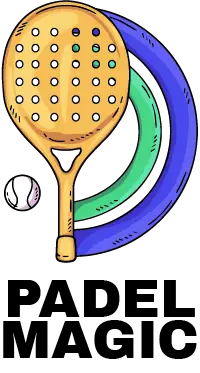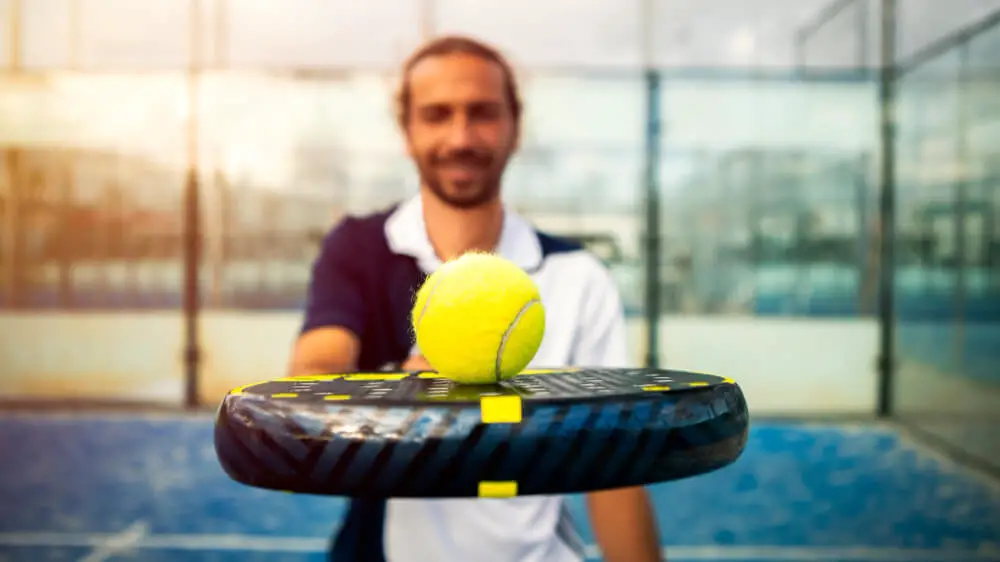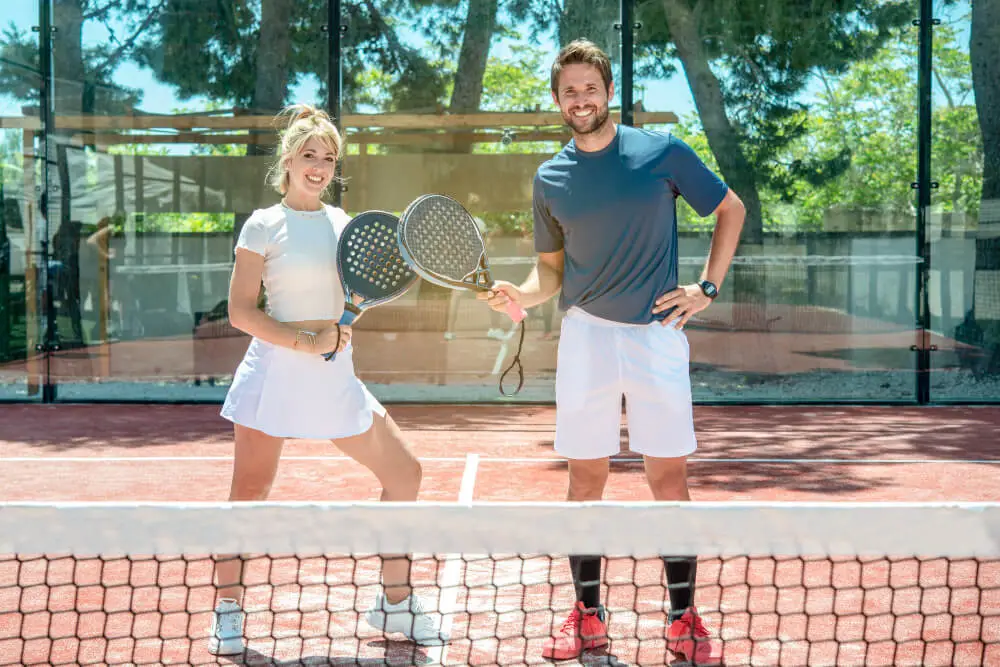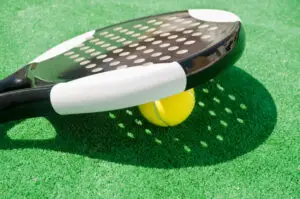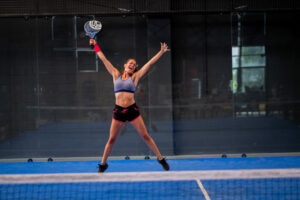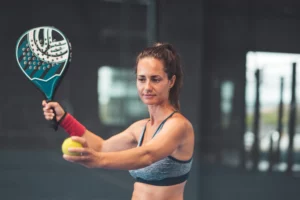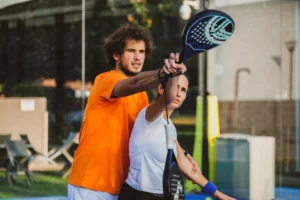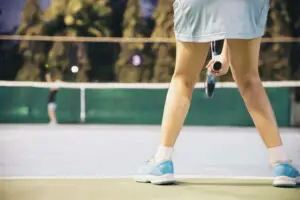Padel For Beginners - Everything You Need To Know to Get Started
Welcome, padel beginners! If you’re looking for a fun and dynamic way to take your game to the next level, look no further than Padel Tennis.
This rising sport is quickly becoming more popular among athletes worldwide because of its mix of simplicity and intensity – plus it’s incredibly easy for anyone at any skill level to join in on the action.
In this blog post, we’ll be breaking down everything you need to know about Padel from rules & regulations, strategies & tips all the way up to finding equipment & getting involved with your local community.
How to play padel for beginners?
We’re here to help make sure your first steps into this exciting world are as simple as possible so let’s dive right in!
What is Padel?
Padel is a fast-growing sport that originated in Mexico in the 1960s. It is now popular in over 20 countries and is played by millions of people worldwide.
Padel is similar to tennis with a net in the middle. Players use a racket to hit a ball back and forth over the net, and the objective is to make it difficult for the opposing players to return the ball.
What sets Padel apart from tennis is the court, which is surrounded by walls and glass, making it a more strategic and tactical game. This exciting sport is suitable for all ages and skill levels, whether you are a beginner or a seasoned player.
So, if you are looking for an enjoyable and challenging sport, Padel might just be the one for you.
The Basic Rules of Padel
The basic rules of padel are quite simple and straightforward.
Padel is played on a court that is 20 meters (65 feet) long by 10 meters (32 feet) wide and surrounded by walls or glass. The game is usually played with two teams of two players each, but can also be played one-on-one.
Players use a solid padel racket to hit the ball over the net, which should not exceed 1 meter in height. Each team serves for five points before switching sides, and the first team to score 15 points wins the match. Points can only be scored when serving, so rallies are often short and fast-paced. You can find here information about how to play padel.
The Equipment Needed to Play Padel
In order to play padel, you need the right equipment. Although the game is relatively simple and doesn’t require a lot of specialized gear, having the right stuff is essential for an enjoyable playing experience.
Padel players will need a court, the best padel rackets, balls, and protective eyewear. Court size varies depending on whether you are playing singles or doubles, but all courts should have walls or glass surrounding them to add an extra element of challenge to the game.
padel rackets come in various shapes and sizes, so it’s important to find one that fits your hand comfortably and provides good control over the ball.
Finally, wearing eye protection such as glasses or goggles is highly recommended when playing padel due to its fast-paced nature. With these basics taken care of, you can start enjoying this fun sport with your friends!
How do I choose a padel racket for beginners?
Choosing a padel racket for beginners can be overwhelming, but there are a few factors to consider.
Firstly, the weight of the racket is important, as a lighter racket is generally easier to maneuver.
Secondly, the shape of the padel racket should also be considered, as a round-shaped racket is usually more forgiving for beginners.
Additionally, the balance of the racket should be considered, with a balanced racket being easier to control.
Finally, the grip size of the racket should also be considered, as a smaller grip may be more comfortable for beginners. It’s important to try out different rackets and get a feel for what works best for you before making a purchase.
Getting Started with the Padel Game
The game is fast-paced and strategic, combining elements of tennis with the added challenge of walls around the court.
Whether you’re looking for a new way to stay active or just want to have some fun with your loved ones, padel has something for everyone! So grab your gear and get ready – it’s time to start playing Padel!
Finding a Padel Court
If you’re looking to get into playing padel, the first step is finding a court. Fortunately, this isn’t too difficult as padel courts are becoming increasingly common in many cities and towns around the world.
Additionally, if you have friends who play Padel already they may be able to provide information on where their favorite places to play are located.
Finally, some sports centers and gyms now offer access to indoor or outdoor padel courts so it’s worth checking with them as well. With just a few simple steps, you’ll soon have your own perfect place to practice and hone your skills!
Choosing a Partner
Choosing the right partner for Padel is an important part of having a successful and enjoyable experience.
The ideal partner should be someone who has similar levels of skill, motivation, and commitment as you do. This will ensure that both players are able to challenge each other while still having fun on the court.
Additionally, it’s important to consider compatibility when selecting a padel partner – look for someone who shares your interests and playing style so that you can make the most out of each game.
Learning the basic strokes in Padel
To master this game, it’s essential to learn basic strokes.
The first stroke you should learn is the forehand. This is the most common stroke and is used for both defense and offense.
Once you have mastered the forehand, move on to the backhand. This stroke is essential for playing against players who like to spin the ball.
The third stroke to master is the volley. This is used during the game to pick up fast-moving balls and to hit the ball back to the opponent’s court.
With these basic strokes in your arsenal, you’ll be well on your way to becoming a proficient Padel player.
Understanding the Scoring System
The basic rules of padel scoring are quite simple.
In Padel, the first point of a game is scored as 15, the second as 30, and the third as 40. To win a game, a player/team must score four points with a lead of at least two points.
If the score is tied at 40-40, the game continues until one player/team scores two consecutive points. In some tournaments, a golden point is used to decide the winner of a game tied at 40-40.
To win a set, a player/team must win six games with a lead of at least two games. If the set is tied at 6-6, the winner is the first player/team to score seven points. To win the match, a player/team must win three sets (or two in some cases).
Padel Techniques and Strategies
To get the most out of playing Padel, it’s important to understand its basic padel tips and techniques, and strategies so you can become a successful player.
Forehand and Backhand Groundstrokes
When it comes to playing padel, perfecting your forehand and backhand groundstrokes is essential for success on the court. These shots involve striking the ball during a rally, and with proper technique and form, can deliver a powerful return that your opponent will struggle to handle.
A well-executed groundstroke can be the difference between a point won or lost, making it crucial to practice and refine your skills. Whether you prefer to play offensively or defensively, mastering your forehand and backhand groundstrokes will give you the confidence to take on any opponent and win the game.
Volleying
Volleying is a crucial skill in padel that can set you apart from the competition. This fast-paced game requires quick reflexes, good hand-eye coordination, and precise timing, all of which can be developed through practice.
When it comes to volleying, the key is to anticipate the ball’s path and position yourself accordingly. By staying close to the net and keeping a low center of gravity, you can react more quickly to incoming shots and control the pace of the game. With these techniques in mind, you’ll be able to improve your volleying skills and dominate the padel court.
Padel Serve and Return
What sets Padel apart from other racquet sports is the concept of serve and return – a crucial component of the game that requires precision and strategy.
Unlike tennis, players serve underhand in padel and a successful serve sets up the opportunity for an aggressive return, which could potentially win the point. This rapid-fire exchange of serves and returns is what makes Padel such an exciting game to watch and play.
Padel Overhead Smash
When it comes to Padel, there’s no denying that the overhead smash is one of the most exhilarating shots in the game.
There’s just something about the sound of the ball meeting the racket at the perfect angle, soaring high over the net, and landing squarely in the opponent’s court that makes every player’s heart race with excitement.
No matter your skill level, mastering the overhead smash is key to dominating the court and securing those hard-earned points. Whether you’re playing for fun or competing at a high level, the overhead padel smash is a shot that never fails to impress and captivate both players and spectators alike.
Padel Lob and Drop Shot
Lob and drop shots are two crucial techniques that every Padel player should master to increase their chances of winning the game.
The Lob shot is used to send the ball high over the net toward the back of the opponent’s court. This technique is particularly effective in situations where you need to defend yourself against a particularly fast shot or a hard-to-reach ball.
On the other hand, the Drop shot is played from the net and is aimed at deceiving your opponent by sending the ball short, low to the ground, and as close to the net as possible. This technique can be an excellent way to catch your opponent off-guard, making it difficult for them to respond quickly. By mastering these two techniques, your opponents will find it difficult to anticipate your next move, giving you the upper hand in the game.
Offensive and defensive strategies Padel game
When it comes to the Padel game, offensive and defensive strategies are essential to succeed.
A good offense is all about taking control of the game and constantly putting pressure on your opponents. This means hitting powerful shots, aiming for corners, and making your opponents move around the court.
On the other hand, having a strong defense is equally important. This involves anticipating your opponent’s shots, staying in the right position, and returning the ball with precision.
Balancing offense and defense is key to winning in Padel, and the best players are those who can seamlessly switch between the two strategies based on the situation. With the right mindset and tactics, you can dominate the court and outsmart your opponents in every game.
Padel Drills for Beginners
Padel drills are an essential part of mastering the sport and can help beginners become more familiar with basic techniques such as forehand and backhand groundstrokes, volleying, serve and return shots, overhead smash, lobs, drop shots, and defensive/offensive strategies.
With just a few simple steps and some dedicated practice time each week, you’ll soon be on your way to becoming a successful player on the court. So grab your Padel gear – it’s time for some padel drills!
Warm-up Drills
Warm-up drills are an essential component of any sport and Padel is no different. Before jumping into the game, it’s important to get your body warmed up and ready to perform at its best.
There are a variety of different warm-up drills that you can incorporate into your Padel routine, from stretching exercises to footwork drills.
By taking the time to properly warm up your muscles and prepare your body for the physical demands of the game, you’ll be able to play with greater agility, speed, and precision.
Groundstroke Drills
Groundstroke drills are one of the best ways to improve your technique and agility on the court. With repeated practice, you can learn to control the ball better and make accurate shots.
Groundstroke drills can also help you build stamina and improve your footwork, allowing you to move more easily and quickly. By incorporating these drills into your training regimen, you can become a better padel player and enjoy more success on the court. With persistence and dedication, you can master the art of padel and take your game to the next level.
Volley Drills
Incorporating volley drills into your practice routine can help you become a more well-rounded player.
By practicing these drills, you can improve your hand-eye coordination, reaction time, and accuracy in hitting the ball.
One drill you can try is the backhand volley drill, where you hit balls off the back wall with your backhand. As you become more comfortable with the drill, you can increase the speed and angle of the shots to challenge yourself.
Serve and Return Drills
Serve and return drills are fundamental to mastering the Padel game. Players who prioritize these drills vastly improve their ability to anticipate and return their opponent’s shots, leading to greater success on the court.
A key aspect of serve and return drills is the emphasis on quick reflexes and footwork, enabling players to quickly move from one shot to the next with precision and control.
As with any sport, consistency is key, and repetition of these drills builds confidence and improves overall performance.
Partner Drills
Whether you’re a beginner or a seasoned veteran, practicing with a partner can enhance your game in various ways. Not only can it improve your footwork and reaction time, but it can also help develop your communication and teamwork skills on the court.
By working with a partner, you can focus on mastering specific shots and strategies, such as lobs, drops, and volleys, which will ultimately elevate your level of play. Plus, it never hurts to have someone to share in the fun of the game with!
Common Mistakes to Avoid
There are common mistakes beginners make when learning the basics of this racquet sport – from poor technique to misreading shots – which can lead to frustration and difficulty progressing in the game.
To ensure you get off on the right foot with Padel, it’s important to be aware of these common pitfalls so you can avoid them altogether. We’ll discuss some of the most common mistakes made by new players as well as how to prevent them from happening again.
Grip Errors
When it comes to playing Padel, having a good grip is essential. However, even the most experienced players can make grip errors from time to time.
Whether it’s due to sweaty palms, a worn-out grip, or simply a lack of concentration, these errors can make or break a game. But don’t worry, there are ways to prevent grip errors and stay on top of your game.
One approach is to invest in a high-quality grip that suits your playing style and provides ample traction.
Another tip is to keep a towel nearby to wipe your hands and grip as needed. By taking these small but important steps, you can minimize the risk of grip errors and boost your chances of winning your next Padel match.
Poor Footwork
The ability to move quickly and maintain balance is of utmost importance when playing Padel, and footwork plays a crucial role in achieving these skills. Without proper footwork, players can find themselves off-balance, slow to react, and overall less precise in their game.
By focusing on improving their footwork, players can ensure that they are not held back by this common issue, and instead, set themselves up for success on the court. By practicing footwork drills and spending time on strengthening this particular area, players can take their game to the next level and improve their overall performance in a big way.
Overhitting the Ball
Overhitting the ball can be a common problem that can quickly turn the tide of a match. It may seem like the harder you hit the ball, the better the outcome, but that’s not always the case.
Overhitting can throw off your accuracy and make it easier for your opponent to return the ball. Instead of focusing on power, work on precision and placement.
Stay calm and focused, and don’t let the adrenaline of the game take over. With practice and patience, you can avoid overhitting and gain better control of the game.
Failure to Communicate with Partner
Communication is the key to any successful partnership, including playing Padel.
Whether it’s discussing strategy or simply keeping each other motivated throughout the game, a lack of communication can lead to frustration and ultimately result in failure. It’s important to understand each other’s strengths and weaknesses and play to them accordingly.
Even if you don’t agree with every decision, openly discussing your thoughts and feelings will lead to better overall performance. So next time you step onto the padel court with your partner, remember to communicate effectively and watch your game improve.
Not Positioning Oneself Correctly
Padel Positioning is key when it comes to playing Padel, as one wrong move can result in the loss of a point. However, sometimes even the most skilled players make the mistake of not positioning themselves correctly on the court. Whether it’s being too far back or too close to the net, improper positioning can leave you vulnerable to your opponent’s shots.
To avoid this, it’s important to be aware of your positioning at all times and make adjustments when necessary. With practice and focus, you can improve your positioning and take your Padel game to the next level.
Etiquette and Safety
Proper etiquette and safety protocols are essential for any sport, including Padel. By following the rules of the game and respecting your opponents, you can ensure that everyone has a safe and enjoyable experience on the court.
Additionally, learning about proper hand gestures, warm-up techniques, clothing requirements, and other guidelines will help you remain injury-free while playing this exciting racquet sport.
With these tips in mind, you can play with confidence knowing that both yourself and others around you are protected from harm.
Court Etiquette
When it comes to playing Padel, knowing the ins and outs of court etiquette can greatly enhance the experience for everyone involved.
Firstly, it’s important to always be respectful to your opponents, both in victory and defeat.
Additionally, avoid interrupting play by keeping still while your opponents are hitting the ball.
And of course, always follow the rules and regulations of the game to ensure fair play.
By practicing proper court etiquette, you’ll not only improve your own skills but also contribute to a more enjoyable and sportsmanlike environment for all players involved.
Proper Attire and Footwear
As with any sport, choosing the right clothing and shoes can impact your performance on the court.
Comfort and functionality are key, so make sure to wear breathable and moisture-wicking fabrics that allow for ease of movement.
As for footwear, opt for tennis shoes with a non-marking sole that provides support and stability for quick lateral movements. By ensuring that you have the appropriate attire and footwear, you’ll not only improve your performance on the court but also reduce your risk of injury.
Safety considerations
The game may be less physically demanding than some sports, but it still requires proper precautions and equipment to minimize the risk of injury.
This includes wearing appropriate footwear with a good grip, using protective eyewear, and warming up before playing to reduce the likelihood of strains or sprains.
Additionally, players should be mindful of others on the court and follow the rules and etiquette of the game to avoid collisions or accidents. By taking these safety considerations seriously, players can enjoy a fun and competitive game of Padel while minimizing the risk of harm.
Conclusion
Overall, Padel is a great game that provides hours of fun and physical activity. With dedication and practice, anyone can become an expert in this sport. Learning the three main strokes – forehand, backhand, and volley – will give you a solid foundation to build on as you progress through your padel journey.
Additionally, it’s important to remember proper etiquette while playing with others and prioritize safety protocols at all times. By following these simple tips plus regular practice sessions each week, soon enough you’ll be able to take your Padel skills up a notch! So what are you waiting for? Grab your racquets and hit the court today!
